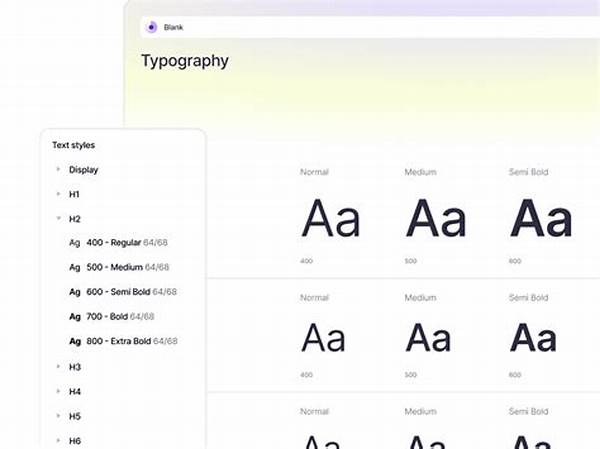In today’s digital age, creating a website that works seamlessly across different devices is no longer a luxury, but a necessity. A crucial component of this is ensuring that typography remains readable and aesthetically pleasing, regardless of screen size. This is where scalable type for responsive design comes into play—a method that enables designers to maintain a consistent look and feel across various devices. Through this technique, typography adapts proportionally as the screen size changes, ensuring optimal user experience without compromising the visual integrity of the website.
Read Now : Legendary Warriors’ Conflict
Understanding Scalable Type
Scalable type for responsive design is a key concept in modern web development, aiming to make text adaptable across different screen sizes and resolutions. Traditionally, web designers have struggled with maintaining font legibility and aesthetics, especially when dealing with the diversity of devices available today. By implementing scalable type, designers can ensure that text remains readable without losing visual appeal. This technique involves using relative units like percentages and ems, or more recently, CSS functions like `clamp()` and `calc()`, to define font sizes. As a result, the typography can adjust dynamically, providing a seamless experience on both small and large screens. The ultimate goal is to ensure consistency and accessibility across multiple platforms, which is crucial in an era where user experience is paramount.
Benefits of Scalable Type
1. Consistency Across Devices: Scalable type for responsive design ensures that a website’s typography remains consistent across all devices, providing a uniform user experience.
2. Improved Readability: The use of scalable type enhances readability, especially on smaller screens, by adjusting font sizes automatically to fit the device.
3. Enhanced Design Flexibility: Designers enjoy more flexibility, as scalable type allows for creative typography solutions that can adapt to different layouts without major reworks.
4. Better Accessibility: With scalable type, it becomes easier to cater to users with low vision or other accessibility needs, as text can be resized appropriately.
5. Future-Proof Design: By using scalable type for responsive design, websites are better prepared for future devices with varying screen sizes, ensuring longevity and relevance.
Implementing Scalable Type
Implementing scalable type for responsive design requires a strategic approach that combines the right tools and techniques. Web developers often rely on CSS units such as ems and rems to define scalable typography relative to the root element. These units make it easy for text to resize proportionally with the device’s screen. Another technique involves using CSS media queries to apply different font sizes based on the viewport width. More advanced methods include CSS functions like `clamp()` and `calc()`, which allow for precise control over font scaling within specified limits. The combination of these techniques enables designers to create a harmonious balance between text size and overall layout, providing an optimal user experience across different devices. By prioritizing scalable type, designers ensure that their website remains accessible and visually appealing to a diverse audience.
Challenges and Solutions in Scalable Type
1. Variable Screen Sizes: The vast range of screen sizes can make it challenging to establish a one-size-fits-all solution for typography. Scalable type helps mitigate this by adjusting automatically.
2. Complex Layouts: Incorporating scalable type into intricate designs can be tricky. By using `rem` and `em` units, designers can create layouts that flexibly adapt to different screens.
3. Performance Concerns: Large-scale typography adjustments may impact performance. Strategically using `clamp()` and media queries helps maintain fast loading times while achieving the desired result.
4. Browser Compatibility: Not all methods of scalable type are supported across older browsers. Testing and fallback solutions ensure consistent functionality.
5. Design Consistency: Maintaining a consistent look across pages is important. Careful application of style guides and CSS standards assures uniform typography across a site.
Read Now : Securing Rights Upon Contract Termination
6. Responsive vs. Adaptive Designs: Balancing the nuances between responsive and adaptive design can be challenging. Scalable type often works better in responsive designs due to its fluid nature.
7. User Accessibility: Ensuring text is readable and accessible for all is key. Relative sizing helps meet various accessibility standards and user preferences.
8. Content Management Systems: Integrating scalable type within CMS platforms can introduce complexities. Thorough testing and appropriate setup are required for optimal results.
9. Visual Hierarchy: Maintaining visual hierarchy is critical in design. `rem` and `clamp()` adjustments help ensure primary content stands out.
10. Testing and Iteration: Regular testing across different devices is essential to ensure scalable type works effectively, refining solutions based on feedback and performance data.
Practical Applications
Designers aiming to employ scalable type for responsive design must understand the practical applications and benefits of this approach. The move towards relative units like `em` and `rem` not only allows typography to scale with screen changes but also aligns with users’ preferences and accessibility needs. For instance, older users or those with vision impairment benefit from responsive design that makes reading easier without zooming or scrolling horizontally. Moreover, designers striving for creativity can experiment with dynamic type sizes that enhance user engagement. Responsive typography also complements grid-based layouts, allowing content to flow naturally. In essence, implementing scalable type harmonizes the aesthetic needs of a brand with the practical expectations of modern users, promoting inclusivity and ease of use.
Aesthetic Considerations
While the primary goal of scalable type for responsive design is functionality, aesthetic considerations should not be overlooked. Typography is a vital element of brand identity and visual narrative, and scalable solutions must respect this. Designers can use scalable type to create visually striking and harmonious digital experiences. By carefully choosing typefaces and understanding their scaling properties, they can maintain coherence and attractiveness even on diverse devices. Decorative fonts, headlines, and body texts can be adjusted thoughtfully to preserve their impact, ensuring that users receive a seamless and enjoyable visual journey, regardless of the screen they are using.
Summary of Scalable Type
The importance of scalable type for responsive design cannot be overstated in the contemporary digital landscape. Its ability to ensure consistency and readability across devices makes it a cornerstone of effective web design. By employing scalable type, designers create a more inclusive digital space where users are met with content that is accessible and appealing. This approach not only supports diverse user needs but also strengthens brand storytelling through consistent and adaptive typography.
Moreover, scalable type future-proofs web content by preparing sites for technological advancements and new device introductions. Web developers are encouraged to adopt scalable type techniques like using `rem`, `em`, `clamp()`, and media queries, recognizing these as powerful tools in the pursuit of design excellence. While challenges such as browser compatibility and layout integration may arise, the benefits of scalability—ensured accessibility, dynamic design capabilities, and improved user experience—outbalance these hurdles. In sum, scalable type for responsive design represents both a necessary adaptation to evolving technology and a critical step towards emphasizing user-focused digital narratives.



